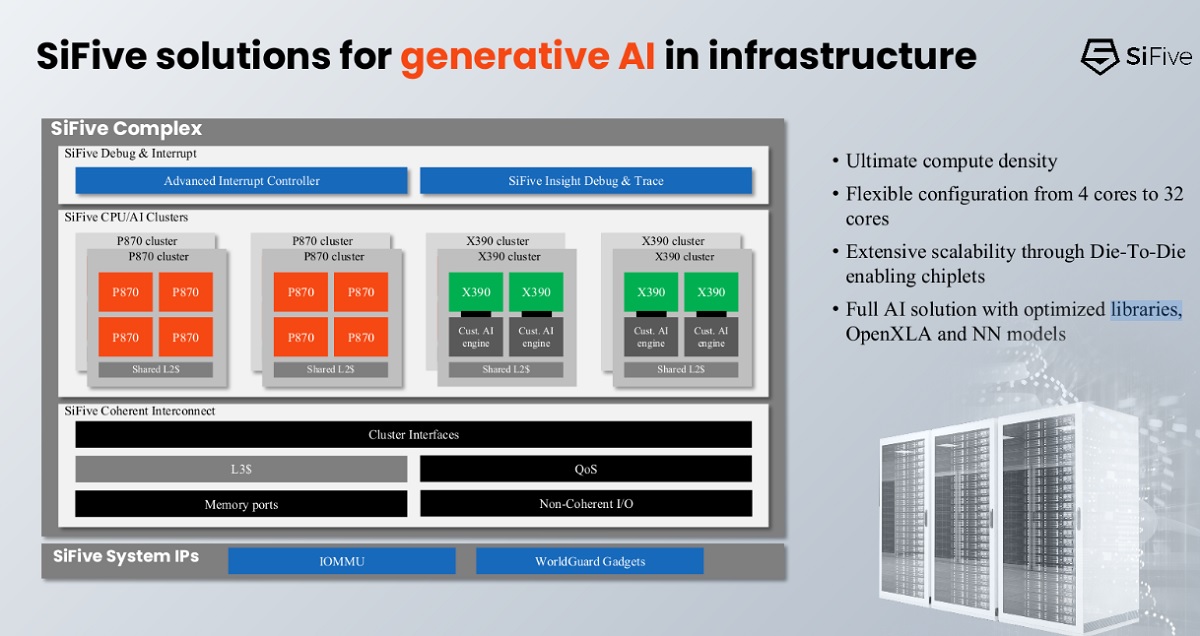SiFive unveils two new high-performance RISC-V processors

SiFive, a RISC-V processor design firm, unveiled two new chip designs aimed at bringing a high-performance computing solution to various industries.
The announcement of the SiFive Performance P870 and SiFive Intelligence X390 took place at an in-person press and analyst event in Santa Clara, California. SiFive designs chips based on the open RISC-V architecture, which competes with architectures from Arm and Intel.
The SiFive Performance P870 and SiFive Intelligence X390 offer low power consumption, compute density, and vector compute capability. These processors aim to provide a significant performance boost for data-intensive computing applications in the fields of consumer electronics, automotive technology, and infrastructure.
SiFive executives highlighted the company’s commitment to driving high-performance RISC-V innovation and bridging the gap with other instruction set architectures. They emphasized the rapid expansion of the RISC-V ecosystem, which is fueled by the growing demand for semiconductors in sectors such as consumer electronics and infrastructure.
Event
GamesBeat Next 2023
Join the GamesBeat community in San Francisco this October 23-24. You’ll hear from the brightest minds within the gaming industry on latest developments and their take on the future of gaming.
Learn More
SiFive CEO Patrick Little said in a statement, “The flexibility of SiFive’s RISC-V solutions allows companies to address the unique computing requirements of these segments and capitalize on the momentum around generative AI, where we have seen double-digit design wins, and for other cutting-edge applications.”

The SiFive Performance P870 is designed for high-performance consumer applications and can also be used alongside a vector processor in data centers. It sets a new standard for RISC-V performance in terms of instruction set architecture availability, throughput, parallelism, and memory bandwidth.
With a 50% peak single-thread performance upgrade over previous SiFive Performance processors, the P870 features a six-wide out-of-order core and a shared cluster cache that enables up to a 32-core cluster.
The SiFive Intelligence X390 builds upon the success of its predecessor, the SiFive Intelligence X280, in combining AI and ML applications with hardware accelerators for mobile, infrastructure, and automotive applications.
The X390 offers a four-fold improvement in vector computation with its single-core configuration, doubled vector length, and dual vector ALUs. This leads to quadruple the amount of sustained data bandwidth. The SiFive Vector Coprocessor Interface eXtension (VCIX) allows companies to add their own vector instructions and/or acceleration hardware, providing unprecedented flexibility and performance enhancement.
SiFive’s combined solution of the P870 and X390, along with a high-performance NPU cluster, provides product designers with an agile and programmable solution for generative AI applications. This solution offers superior compute density, low power consumption, and exceptional flexibility for complex workloads.
SiFive highlighted the strong interest from customers in these combined solutions, with several achieving success in silicon development and commercialization using high-performance SiFive products.
The company continues to collaborate with partners across the ecosystem to ensure that software, security, and flexibility benefits of the open standard RISC-V ecosystem are readily available for SiFive processors, enabling companies to commercialize their SiFive-powered products.
SiFive is one of the pioneers of RISC-V and it said it is committed to transforming the future of computing by harnessing the limitless potential of RISC-V for high-performance and data-intensive applications. Little said in a press briefing that the firm has raised hundreds of millions of dollars and has over 500 employees in multiple locations.
He said the company has 350 design wins and customers include Intel, Amazon, Qualcomm, Samsung, Google, NASA and more. SiFive started in the embedded market and moved up the food chain to high-performance cores.
“These customers helped us earn our way,” Little said. “Even when we sell high-performance cores, a lot of companies will need embedded cores too.”
He said the prior P600-Series is the highest-performing RISC-V processor that you can license.
“We shipping these in volume,” he said.
As for competition, Little said it’s a two-horse race between SiFive and Arm. He noted every one of Arm’s top customers are also SiFive’s top customers. Especially in mobile. It may take a few years to bear full fruit, but he noted the SiFive chips have 30% to 40% better power efficiency and compute density than Arm.
Arm has been around for decades and it recently went public at a valuation of $54.5 billion. Little said RISC-V is the fastest-growing software ecosystem.
Nvidia rules data centers with its AI processors and graphics processing units. Krste Asanovic, founder of SiFive, said those processors are often duct-taped together.
For something like AI-based security components, you need a complete solution, he said. He said AI and general-purpose computing are shifting to RISC-V, as AI needs agile hardware. SiFive can provide complete solutions around the core chips in a system.
“We don’t have these different systems that we duct-tape together,” Asanovic said. “We are a very broad portfolio and within that broad portfolio we provide all the pieces.”
Little said customers doing new categories of computing are more likely to pick RISC-V over Arm, as long as they are not locked in. Arm is trying to get into the core of processors in data centers to compete with Intel and Advanced Micro Devices, but Asanovic said RISC-V is not yet there because of a “massive software lift” that would have to happen to enable it.
Little said the company is also making good headway in penetrating various U.S. government procurements.
GamesBeat’s creed when covering the game industry is “where passion meets business.” What does this mean? We want to tell you how the news matters to you — not just as a decision-maker at a game studio, but also as a fan of games. Whether you read our articles, listen to our podcasts, or watch our videos, GamesBeat will help you learn about the industry and enjoy engaging with it. Discover our Briefings.



